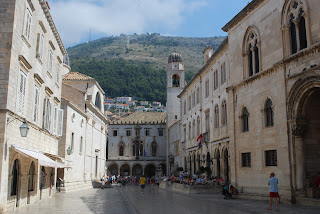(This
is a continuation of my previous blog entry, describing my recent visit to
Croatia)
I
can recommend our hotel at Dubrovnik, which was the Valamar Argosy, on the
coast at the outlying district of Babib Kuk (which, we were told, means
“Grandmother’s Hip”, owing to a Turkish misunderstanding of the Serbo-Croat
name). It had good rooms, good food and a splendid outdoor pool, and had the
inestimable benefit of being the terminus of the No. 6 bus to the old city, so
it was impossible to get lost. Ciccadas were very noisy in the trees, and
swifts were flying very low.
We
had two days in Dubrovnik, separated by an expedition into Montenegro; a very
strange country. The only currency accepted there is the Euro, which is
surprising because Montenegro is not a member of the E.U. It was suggested to
us that the principal business was money-laundering, as shown by the fact that
there were no British banks to be seen, but plenty of Russian ones. To coin a
phrase: I couldn’t possibly comment… In the wars of the 1990s, the Montenegrans
supported Serbia in the bombardment of Dubrovnik (see later).
We
had two stops there, at Perast on the Bay of Kotor,
and then at the city of Kotor itself.
Both these places were devastated by a massive earthquake in 1979, and were
rebuilt as they had been; but as my parents’ Communist-era guidebook said, it
was unlikely that all the architectural details could ever be reconstructed.
So
Kotor is still a mediaeval city, with defensive walls running up the
precipitous mountainside behind, and a tangle of alleyways from which motor
vehicles are excluded. We were issued with maps, but since hardly any of the
narrow, twisted streets bore names, it was very easy to get lost.
I found the easiest strategy was simply to hand the map to a shopkeeper and ask to be shown where I was. Eventually I managed to find the cathedral and other impressive buildings.
I found the easiest strategy was simply to hand the map to a shopkeeper and ask to be shown where I was. Eventually I managed to find the cathedral and other impressive buildings.
But
the highlight of the week was always going to be Dubrovnik. It was once known
as Ragusa: a strongly-walled mercantile city-state on the Dalmatian coast,
which for centuries managed more or less to retain its autonomy by striking a
balance between the neighbouring powers of Venice, the Ottoman Empire and
Austria-Hungary. It was even occupied by Napoleon’s troops for a brief period
in 1806. In 1815 it was incorporated into the Austrian Empire, and after 1918
assigned to Yugoslavia. This was the position when my parents visited in the
1970s, but when the Yugoslav state fell apart Dubrovnik came under attack from
Serbian and Montenegran forces in 1991-2, and was badly damaged by shellfire.
Repairs have been made, but the episode has not been forgotten: there are maps
posted around the city showing the extent of the destruction.
The
classic view in Dubrovnik is the street called the Stradun, which leads
eastwards from the Pile gate.
Here you can find the church of St. Blaise, the patron saint of the city, with a statue of the hero Roland in front of it,
and close by the Rector's Palace, with a splendid interior courtyard, a museum, and most elaborate capitals to the columns in fornt of the entrance
From the harbour nearby
you can take boat trips along the sea-walls
or out to the Elaphite Islands.
Fine views over the city can be gained by walking a circuit of the walls
but the classic view is obtained by taking the cable-car to Mount Srd, where there is also a monument to those who died defending the city in the 1991-2 "Homeland War"
All this barely scratches the surface of what there is to see in Dubrovnik!


















Yes, in some of the pictures you can see scaffolding and protective fencing. Some of the masonry would be expensive to reproduce in any circumstance.
ReplyDeletePeter, apologies for using you as a conduit but I'm trying to get hold of Graham Attenborough and I wondered if you might be able to put me in touch. If you could drop me a line at andrewhumphreys [at] btinternet.com
ReplyDeleteMany thanks.